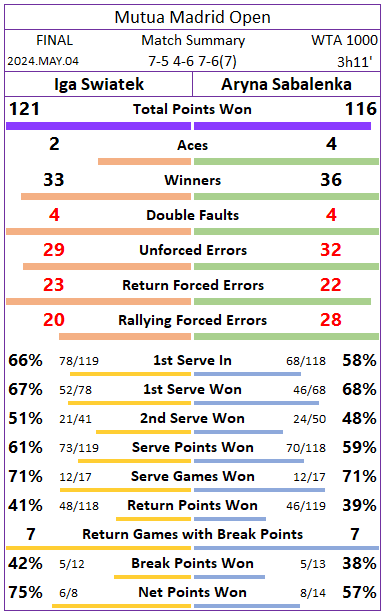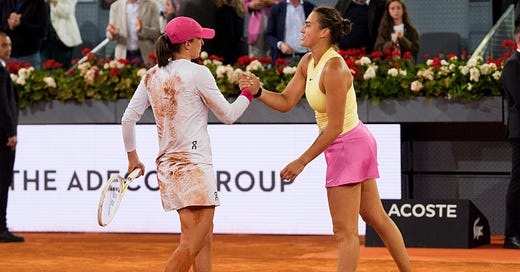Swiatek vs Sabalenka: Madrid Final Analysis (WTA 1000)
Swiatek's serve patterns, adjustments and the differential in "+1s" rallies in a "match-of-the-year" favourite
cover 📸 credit: Mutua Madrid Open twitter
Last year’s WTA 1000 Madrid Open final between Iga Swiatek and Aryna Sabalenka was considered the best Tour match of 2023. Somehow, the top two players in the world upstaged it in this year’s final.
Big time!
The show they put on was a titanic clash of physically-demanding, mentally-testing, powerful, world-class tennis! A crescendo of suspense that reached its climax in the 4th hour.
A match so close…
Rallies won: Swiatek 81, Sabalenka 80
Baseline duels won: Swiatek 71, Sabalenka 70
Break points for/against won: Swiatek 13, Sabalenka 12
30/30 and Deuce points won: Swiatek 14, Sabalenka 14
Winners-to-unforced errors (excluding aces & DFs): Swiatek +4, Sabalenka +4
… that it was decided by a couple of points, literally.
Match points for/against won: Swiatek 4, Sabalenka 1
Ultimately, having the edge in these “couple of points” was what led Swiatek to a first-time WTA 1000 Madrid champion.

The Madrid Final was such a rich match that any single analysis will probably fall short of covering all key topics.
Before our attempt at presenting decisive factors and details that may have escaped the eye test, here is a breakdown of each set.
Set 1 (Swiatek, 7-5)
Swiatek enjoyed a great serving performance: 70% of 1st serves won, including 48% of 1st serves that were unreturned (11/23). Overall, she won 14 points with serves (1st or 2nd) that did not come back. Many of these were delivered at key moments: 3 to save break points; 2 at 30/30 or Deuce; 2 to tie the game score; 1 to clinch a close game.
While Sabalenka had a bit more initiative during rallies, it resulted in 7 more unforced errors.
Unforced errors: Swiatek 5 / Sabalenka 12
Winners-to-unforced errors: Swiatek +7 / Sabalenka -2
2nd serve points won: Swiatek 60% / Sabalenka 31%
Net points won: Swiatek 100% / Sabalenka 40%
Baseline points won: Swiatek 51% / Sabalenka 47%
0-4 shots: Swiatek +3 (31/28)
5+ shots: Swiatek +4 (12/8)
Set 2 (Sabalenka, 6-4)
In the second set, Swiatek’s level of serving dropped. Her 1st serves looked slower and shorter, which resulted in Sabalenka increasing returns in play to 71%. More significantly, Sabalenka won 52% of Swiatek’s 1st serve points.
With an improved performance off the ground (12 winners to 6 unforced errors) Sabalenka dominated from the back of the court. She won 63% of baseline points and limited Swiatek’s win-rate to 36% (13/36).
Winners-to-unforced errors: Swiatek +1 / Sabalenka +6
Baseline points won: Swiatek 36% / Sabalenka 63%
1st serve points won: Swiatek 48% / Sabalenka 60%
2nd serve points won: Swiatek 45% / Sabalenka 55%
0-4 shots: Sabalenka +8 (26/18)
5-8 shots: Sabalenka +4 (8/4)
9+ shots: Swiatek +5 (6/1)
Set 3 (Swiatek, 7-6 [9-7])
After being pushed around in the 2nd set, Swiatek fought back. She put more power on her serve and hit more aggressive groundstrokes. As a result, her win percentage behind 1st serves increased to 76% and she inverted baseline win-rates: Swiatek’s climbed to 54% while Sabalenka’s dropped to 43%.
Even though Swiatek hit 2 less winners and 2 more unforced errors, those were not concerning numbers because they were outweighted by her massive 5-16 advantage difference in forced errors during rallies. That was the defining stat of the third set.
Rallying forced errors: Swiatek 5 / Sabalenka 16
Winners-to-unforced errors: Swiatek -4 / Sabalenka 0
1st serves made: Swiatek 69% / Sabalenka 43%
Baseline points won: Swiatek 54% / Sabalenka 43%
0-4 shots: Swiatek +1 (33/32)
5-8 shots: Swiatek +3 (12/9)
9+ shots: Swiatek +1 (5/4)
It is mind-boggling how, in a match of this magnitude and after 237 points, a single point was the difference in both total rallies won and baseline duels won.
Rallies won: Swiatek 81, Sabalenka 80
Baseline duels won: Swiatek 71, Sabalenka 70
Fittingly, as there are no ties in tennis, it was the final point that prevented stalemates and created the ultimate difference.
Some interesting numbers emerged when we divided rallies according to the pattern in play when the point-defining shot was struck.
Swiatek had the edge in forehand-to-forehand tussles (+7 Deuce side) or when no crosscourt pattern was in play (+6 Alternating sides) while Sabalenka was superior in backhand-to-backhand duels (+3 AD side).
But the most intriguing data came from “+1s” rallies. These were responsible for the outcome of 60% of rallies (97/161) and created the biggest gap between players: a 9-point advantage for Sabalenka (53 points won, 44 lost).
Here, “+1s” rallies included all points ending on winners and errors made in the first shot of each player after the serve or return (also called as serve+1 and return+1) AND points that required an additional but relatively easy put-away shot that was set up by the preceding and difference-making “+1” shot.
Remarkably, as the red circle highlights in the table below, all of Sabalenka’s advantage in “+1s” rallies derived from a 16-6 score during the 2nd set.

Further considerations on the topic will be addressed later, as they link with what we considered one of the most fascinating and dynamic storylines of the match:
Swiatek's serve patterns, adjustments and the differential in "+1s" rallies






